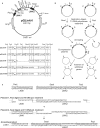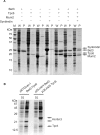Vectors for co-expression of an unrestricted number of proteins
- PMID: 17311810
- PMCID: PMC1874614
- DOI: 10.1093/nar/gkm067
Vectors for co-expression of an unrestricted number of proteins
Abstract
A vector system is presented that allows generation of E. coli co-expression clones by a standardized, robust cloning procedure. The number of co-expressed proteins is not limited. Five 'pQLink' vectors for expression of His-tag and GST-tag fusion proteins as well as untagged proteins and for cloning by restriction enzymes or Gateway cloning were generated. The vectors allow proteins to be expressed individually; to achieve co-expression, two pQLink plasmids are combined by ligation-independent cloning. pQLink co-expression plasmids can accept an unrestricted number of genes. As an example, the co-expression of a heterotetrameric human transport protein particle (TRAPP) complex from a single plasmid, its isolation and analysis of its stoichiometry are shown. pQLink clones can be used directly for pull-down experiments if the proteins are expressed with different tags. We demonstrate pull-down experiments of human valosin-containing protein (VCP) with fragments of the autocrine motility factor receptor (AMFR). The cloning method avoids PCR or gel isolation of restriction fragments, and a single resistance marker and origin of replication are used, allowing over-expression of rare tRNAs from a second plasmid. It is expected that applications are not restricted to bacteria, but could include co-expression in other hosts such as Bacluovirus/insect cells.
Figures




Similar articles
-
A family of E. coli expression vectors for laboratory scale and high throughput soluble protein production.BMC Biotechnol. 2006 Mar 1;6:12. doi: 10.1186/1472-6750-6-12. BMC Biotechnol. 2006. PMID: 16509985 Free PMC article.
-
Regulation of ER-associated degradation via p97/VCP-interacting motif.Biochem Soc Trans. 2008 Oct;36(Pt 5):818-22. doi: 10.1042/BST0360818. Biochem Soc Trans. 2008. PMID: 18793143
-
Development of a novel Gateway-based vector system for efficient, multiparallel protein expression in Escherichia coli.Protein Expr Purif. 2008 Jun;59(2):232-41. doi: 10.1016/j.pep.2008.02.003. Epub 2008 Feb 21. Protein Expr Purif. 2008. PMID: 18375142
-
Strategies for optimization of heterologous protein expression in E. coli: Roadblocks and reinforcements.Int J Biol Macromol. 2018 Jan;106:803-822. doi: 10.1016/j.ijbiomac.2017.08.080. Epub 2017 Aug 19. Int J Biol Macromol. 2018. PMID: 28830778 Review.
-
Overcoming challenges for amplified expression of recombinant proteins using Escherichia coli.Protein Expr Purif. 2018 Apr;144:12-18. doi: 10.1016/j.pep.2017.11.005. Epub 2017 Nov 24. Protein Expr Purif. 2018. PMID: 29180019 Review.
Cited by
-
Crystal structure of a bacterial homologue of glucose transporters GLUT1-4.Nature. 2012 Oct 18;490(7420):361-6. doi: 10.1038/nature11524. Nature. 2012. PMID: 23075985
-
The multifaceted benefits of protein co-expression in Escherichia coli.J Vis Exp. 2015 Feb 5;(96):52431. doi: 10.3791/52431. J Vis Exp. 2015. PMID: 25742393 Free PMC article.
-
Structural mechanism of SGLT1 inhibitors.Nat Commun. 2022 Oct 28;13(1):6440. doi: 10.1038/s41467-022-33421-7. Nat Commun. 2022. PMID: 36307403 Free PMC article.
-
Getting a grip on complexes.Curr Genomics. 2009 Dec;10(8):558-72. doi: 10.2174/138920209789503923. Curr Genomics. 2009. PMID: 20514218 Free PMC article.
-
De novo designed proteins from a library of artificial sequences function in Escherichia coli and enable cell growth.PLoS One. 2011 Jan 4;6(1):e15364. doi: 10.1371/journal.pone.0015364. PLoS One. 2011. PMID: 21245923 Free PMC article.
References
-
- Kümmel D, Müller JJ, Roske Y, Henke N, Heinemann U. Structure of the Bet3-Tpc6B core of TRAPP: two Tpc6 paralogs form trimeric complexes with Bet3 and Mum2. J. Mol. Biol. 2006;361:22–32. - PubMed
-
- Heinemann U, Büssow K, Mueller U, Umbach P. Facilities and methods for the high-throughput crystal structure analysis of human proteins. Acc. Chem. Res. 2003;36:157–163. - PubMed
Publication types
MeSH terms
Substances
LinkOut - more resources
Full Text Sources
Other Literature Sources
Research Materials
Miscellaneous

